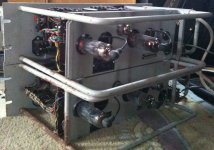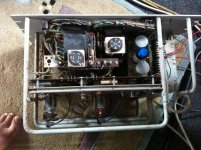On Sunday, I repaired a pair of Philips EL6416 amplifiers that I purchased online. It took most of the day and I'm an excellent technician on this stuff!
These are commercial amps and have been rather neglected. They were dirty and have some rust on various parts. I'm not going to fix up the cosmetics, it would require complete dismantling.
One was distorting because of a faulty EL36. Unusually, it was warming up just the same as it's mate, but not producing any output. Usually a faulty valve will not get hot as it doesn't pass much current.
Many other things needed sorting:
1)Replaced all electrolytic capacitors.
2)Fitted trimpot to adjust output valve bias, so I could adjust to minimum distortion.
3) Found the amps made high distortion at low frequencies. For some unknown reason, the value of each capacitor feeding signal to the grids of the output valves was different. One valve had 0.47uF and the other had 0.047uf. This is consistent with the schematic. At low frequencies these have widely different capacitive reactance so the signal to each valve is different. This produces more second harmonic distortion as the frequency reduces. At 50Hz the distortion was around 5% with original values; after making both capacitors 0.47uf the distortion dropped to 0.6%.
4) The power output was low. Found the DC voltages were low. The selenium rectifiers were not performing well, having a high voltage loss. Bridged them with silicon diodes and the voltages came up to spec.
5) Adjusted bias to minimum distortion.
The amps perform better than I expected from a commercial amp of it's type. (Basically a PA amp.)
On 10 Volt output they produce 35 Watts into 4 Ohms and 20 Watts into 8 Ohms.
On 25 Volt output they produce 32 Watts into 16 Ohms.
Distortion at 1 Watt is around 0.2% midband rising to about 0.6% at low and high frequencies.
Similar distortion at 20 Watts but low frequency distortion rises above this power as the output transformer runs out of steam.
Frequency response at powers up to 20 Watts is 20Hz to 20KHz +0,-0.5dB.
Have them on my stereo and they perform very nicely, stayed up late listening to music on them last night.
I am using Gale 402 speakers, which are very inefficient. They are 4 Ohms. I normally use an amp of 600 Watts per channel. Have been using a class A transistor amp of 30 Watts per channel and it is just too weak for decent listening. The Philips valve amps do go loud enough for decent listening.
I have had a pair of McIntosh 30 Watt amps on these speakers and I think the Philips are more grunty and sound better.
Also had an Audio Research D115 amp for a while on these speakers and while it was louder than the Philips, I think I prefer the sound of the Philips. (That was over a year ago, so it's not an accurate observation.)
These are commercial amps and have been rather neglected. They were dirty and have some rust on various parts. I'm not going to fix up the cosmetics, it would require complete dismantling.
One was distorting because of a faulty EL36. Unusually, it was warming up just the same as it's mate, but not producing any output. Usually a faulty valve will not get hot as it doesn't pass much current.
Many other things needed sorting:
1)Replaced all electrolytic capacitors.
2)Fitted trimpot to adjust output valve bias, so I could adjust to minimum distortion.
3) Found the amps made high distortion at low frequencies. For some unknown reason, the value of each capacitor feeding signal to the grids of the output valves was different. One valve had 0.47uF and the other had 0.047uf. This is consistent with the schematic. At low frequencies these have widely different capacitive reactance so the signal to each valve is different. This produces more second harmonic distortion as the frequency reduces. At 50Hz the distortion was around 5% with original values; after making both capacitors 0.47uf the distortion dropped to 0.6%.
4) The power output was low. Found the DC voltages were low. The selenium rectifiers were not performing well, having a high voltage loss. Bridged them with silicon diodes and the voltages came up to spec.
5) Adjusted bias to minimum distortion.
The amps perform better than I expected from a commercial amp of it's type. (Basically a PA amp.)
On 10 Volt output they produce 35 Watts into 4 Ohms and 20 Watts into 8 Ohms.
On 25 Volt output they produce 32 Watts into 16 Ohms.
Distortion at 1 Watt is around 0.2% midband rising to about 0.6% at low and high frequencies.
Similar distortion at 20 Watts but low frequency distortion rises above this power as the output transformer runs out of steam.
Frequency response at powers up to 20 Watts is 20Hz to 20KHz +0,-0.5dB.
Have them on my stereo and they perform very nicely, stayed up late listening to music on them last night.
I am using Gale 402 speakers, which are very inefficient. They are 4 Ohms. I normally use an amp of 600 Watts per channel. Have been using a class A transistor amp of 30 Watts per channel and it is just too weak for decent listening. The Philips valve amps do go loud enough for decent listening.
I have had a pair of McIntosh 30 Watt amps on these speakers and I think the Philips are more grunty and sound better.
Also had an Audio Research D115 amp for a while on these speakers and while it was louder than the Philips, I think I prefer the sound of the Philips. (That was over a year ago, so it's not an accurate observation.)
Attachments
- Status
- Not open for further replies.

